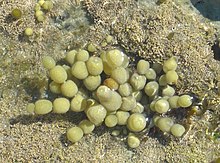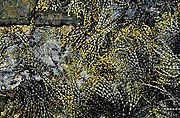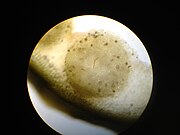Hormosira
| Hormosira | |
|---|---|

| |
| Young Hormosira | |
| Scientific classification | |
| Domain: | Eukaryota |
| Clade: | Diaphoretickes |
| Clade: | SAR |
| Clade: | Stramenopiles |
| Phylum: | Gyrista |
| Subphylum: | Ochrophytina |
| Class: | Phaeophyceae |
| Order: | Fucales |
| Family: | Hormosiraceae Fritsch |
| Genus: | Hormosira (Endlicher) Menegh. |
| Species: | H. banksii
|
| Binomial name | |
| Hormosira banksii | |
Hormosira is a genus of seaweed in the family Hormosiraceae. It is monotypic, with a single species, Hormosira banksii, also known as Neptune's necklace, Neptune's pearls, sea grapes, or bubbleweed[2] it is native to Australia and New Zealand.[1][3]
Distribution[edit]
Hormosira is native to southeastern Australia (including Tasmania, Lord Howe Island and Norfolk Island) and New Zealand.[1][2][3][4][5][6][7] Despite substantial morphological variation across its range, the species represents a single species and the genus Hormosira is monotypic.[5] Genetic analyses of mitochondrial COI and microsatellite DNA sequence data have indicated that there is low genetic variation across the range of the species in Australia.[5][6]
Description[edit]
Hormosira is a perennial[4] species of seaweed (brown algae, Fucales).[3] It is abundant on low-energy rocky reefs within the intertidal zone, where it outcompetes other algal species due to its high tolerance to desiccation. Plants vary significantly in morphology.[5] The thallus (or frond) of the species is made up of strings of olive-brown, spherical, gas-filled pneumatocysts (or beads), which taper towards a small holdfast.[2] While the holdfast attaches strongly to a substrate, it can be easily dislodged by human trampling.[4] The spheres are buoyant and rise to the surface of the water during high tide, allowing plants to move with the flow of the current and obtain more sunlight.[8] Hormosira also produces a slime layer to reduce desiccation,[8] and plants often grows in high densities,[4][7] which reduces their surface area exposed to the sun and further reduce dehydration.[8] Due to the buoyant thallus, Hormosira plants can drift out to sea over considerable distances, and floating plants can remain fertile for several weeks.[5]
-
High densities of Hormosira on a broad rocky platform in Kaikoura, New Zealand
-
High densities of Hormosira at Long Reef, Sydney, Australia
-
Hormosira at Eaglehawk Neck, Tasmania, Australia
-
Hormosira growing alongside a petrified log at Curio Bay, Otago, New Zealand
Reproduction[edit]
Hormosira reproduces sexually and is monoecious. The sex organs (conceptacles) are on the surface of the beads, and are visible to the naked eye as rough-looking dimples.[9] Hormosira produces eggs throughout the year, but its peak reproduction is often confined to July–October (at least in northern New Zealand) when the sea temperature is around 14 °C, as the viability of the eggs can be low in high sea temperatures such as 17–22 °C.[10] At high tide, the eggs are released directly into the surrounding water. The eggs are negatively buoyant they sink to the substrate to develop for several days before becoming attached.[5] All individuals release at the same time, maximising fertilisation. The species can also reproduce asexually from broken and dislodged fragments.
-
Female conceptacle
-
Male conceptacle
Ecology[edit]

Hormosira is regarded as an ecosystem engineer[6] or habitat former[7] that occurs in large patches and outcompetes other algal species due to its high tolerance to desiccation. Hormosira is a food source for sea urchins, many small crustaceans, and some juvenile fish.[8] Young crustaceans and molluscs often rely on the dense canopies of Hormosira for niche space, protection from predators, and avoid desiccation at low tide.[8] Hormosira provides a substrate for sessile organisms to attach onto, including sea urchins and a wide range of facultative and obligate algal epiphytes such as Notheia anomala.[7] This is beneficial to many organisms as competition for habitat space is a primary limiting factor in the intertidal environment.
Uses[edit]
Due to the species high iodine content, Tasmanian schoolchildren were once urged to eat a bead a day to keep the goitres away.[11]
References[edit]
- ^ a b c Huisman, J.M. (2000). Marine Plants of Australia. University of Western Australia Press, Australian Biological Resources Study. ISBN 978-1-876268-33-6.
- ^ a b c "Hormosira banksii". New Zealand Plant Conservation Network. New Zealand Plant Conservation Network. Retrieved 25 June 2021.
- ^ a b c W. A., Nelson (2013). New Zealand seaweeds : an illustrated guide. Wellington, New Zealand: Te Papa Press. p. 70. ISBN 9780987668813. OCLC 841897290.
- ^ a b c d Schiel, D.R.; Taylor, D.I. (1999). "Effects of trampling on a rocky intertidal algal assemblage in southern New Zealand". Journal of Experimental Marine Biology and Ecology. 235 (2): 213–235. doi:10.1016/S0022-0981(98)00170-1.
- ^ a b c d e f Mueller, Rebecca; Wright, Jeffrey T.; Bolch, Christopher J.S. (2018). "Historical demography and colonization pathways of the widespread intertidal seaweed Hormosira banksii (Phaeophyceae) in southeastern Australia". Journal of Phycology. 54: 56–65. doi:10.1111/jpy.12599.
- ^ a b c Bellgrove, Alecia; van Rooyen, Anthony; Weeks, Andrew R.; Clark, Jennifer S.; Doblin, Martina A.; Miller, Adam D. (2017). "New resource for population genetics studies on the Australasian intertidal brown alga, Hormosira banksii: isolation and characterization of 15 polymorphic microsatellite loci through next generation DNA sequencing". Journal of Applied Phycology. 29: 1721–1727. doi:10.1007/s10811-016-1015-0.
- ^ a b c d Thomsen, M.S.; Metcalfe, I.; South, P.; Schiel, D.R. (2016). "A host-specific habitat former controls biodiversity across ecological transitions in a rocky intertidal facilitation cascade". Marine and Freshwater Research. 67 (1): 144–152. doi:10.1071/MF14152.
- ^ a b c d e "Neptunes Necklace". Pathwayz. Pathwayz. Retrieved 3 May 2021.
- ^ "Neptune's necklace". na.oceana.org. Retrieved 17 March 2011.
- ^ Begum, M.; Taylor, F.J. (1991). "Seasonal egg liberation and potential output of Hormosira banksii". Pakistan Journal of Botany. 23: 145–151.
- ^ Edgar, Graham (2012). Australian marine life : the plants and animals of temperate waters (2nd ed.). Chatswood, N.S.W.: Reed New Holland. p. 40. ISBN 9781921517174.
External links[edit]
- Neptune's necklace discussed in RNZ Critter of the Week, 31 Jul 2020






